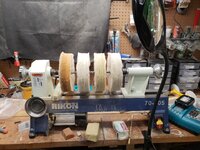Quality Pen
Member
So, I have 2 questions....
Right now I use 2 6" wheels on a 3400RPM grinder. I heard that slower is better, and I also want to use more than 2 wheels in the hopes of saving time.
1) Is there any benefit when it comes to 6 vs 8" wheels?
I know people say speed matters, and an 8" will give a faster (inferior) surface speed, but is it enough to matter? It looks like a 8" wheel gives about a 1/3 increase in surface speed.
My other question is... what are some good options? The suprising thing I read on one of the few slow speed buffers I can even find - https://www.rikontools.com/product/81-608 - is that its recommended run time is 30 minutes. I almost gasped when I read that, considering I didn't think that was even a thing... but I would need to run it for 30 minutes before I even get warmed up!
As always, thanks for the help!
Right now I use 2 6" wheels on a 3400RPM grinder. I heard that slower is better, and I also want to use more than 2 wheels in the hopes of saving time.
1) Is there any benefit when it comes to 6 vs 8" wheels?
I know people say speed matters, and an 8" will give a faster (inferior) surface speed, but is it enough to matter? It looks like a 8" wheel gives about a 1/3 increase in surface speed.
My other question is... what are some good options? The suprising thing I read on one of the few slow speed buffers I can even find - https://www.rikontools.com/product/81-608 - is that its recommended run time is 30 minutes. I almost gasped when I read that, considering I didn't think that was even a thing... but I would need to run it for 30 minutes before I even get warmed up!
As always, thanks for the help!

